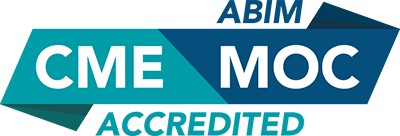Geriatrics and Pain Management for Primary Care
Mar 18, 2022 – Mar 20, 2022
Online Live Stream - CME
This online live stream CME will be broadcasting from one of our in-person CME destinations. This program will be acceptable for up to 12 Prescribed credits by the Accreditation Council for Continuing Medical Education (ACCME) and the American Academy of Family Physicians. This program is accredited as a live activity. Recordings of the event will be provided to all registered attendees at the conclusion of the course.
The online learning format will encourage audience participation through dynamic lectures, and case-based studies. Keynote speakers will present and critically assess recent advancements and industry updates in Primary Care, with the goal of enhancing the knowledge-base and core competence of attendees. The successful completion of this interactive program diagnosing, treating, and prescribing the most effective courses of treatment, with the ultimate goal of improving patient outcomes.
Note: Content is subject to change without notice. Please refer to the activity website for the most current information.
*Please select I do not need lodging for all online live stream CME Events.
Tuition Discount
Past Attendees Save $50: Past MCE Conferences attendees (within the previous three years) automatically receive a $50 discount at checkout.
Bring a Friend or Colleague and Save $50: If you are attending with another healthcare professional you are eligible for a $50 discount.
Overview & Agenda
Geriatrics and Pain Management for Primary Care – 12 Credits
Overview
This conference is designed to provide primary care practitioners with up-to-date, evidence-based information on commonly encountered issues in Geriatrics and Pain Management, while suggesting pragmatic approaches to clinical management. The discussion-based format of the conference will encourage audience participation through dynamic lectures, case-based studies, and hands-on workshops. Keynote speakers will present and critically assess recent advancements and industry updates in Geriatrics and Pain Management with the goal of enhancing the knowledge-base and core competence of attendees. The successful completion of this interactive program diagnosing, treating, and prescribing the most effective courses of treatment, with the goal of improving patient outcomes.
Target Audience
All Physicians and other Healthcare Professionals seeking clinical information about issues in Geriatrics and Pain Management in Primary Care.
Speakers
Our presenting national faculty speakers make it their professional goals to enhance the training of primary care clinicians. This Continuing Medical Education program promises to help you learn the most current, best medicine, and techniques for making the diagnosis easier during a 20-minute office visit.
Topics and Objectives
Friday, March 18
Non-Opioid Pharmacologic Management of Chronic Pain
Objectives: 1) Understand the neurobiology of chronic pain and how this relates to pharmacologic targets 2) Develop a data-driven and practical understanding of dosing, benefits, and side-effects of common non-opioid pharmacologic agents 3) Become versed in pharmacologic algorithms for treating common pain syndromes, such as acute back pain, fibromyalgia, and neuropathic pain
Opioids for Chronic and Cancer Pain: Rationale Prescribing
Objectives: 1) Become comfortable with practical aspects of chronic opioid therapy, including opioid selection, rotation, and side-effect management 2) Appreciate the nuances for titration for different pain syndromes 3) Learn clinical pearls and strategies for managing chronic opioid therapy as safely as possible 4) Discuss the use of opioids for cancer pain and how the approach differs from chronic non-cancer pain
Heart Failure: Assessment and Management of the Most Expensive Disease in Older Adults – Part 1
Objectives: 1) Recognize the high mortality associated with heart failure 2) Understand the difference between reduced ejection fraction and preserved ejection fraction heart failure, and how to diagnose heart failure 3) Know the evidence-based treatments available for heart failure
Heart Failure: Assessment and Management of the Most Expensive Disease in Older Adults – Part 2
Objectives: 1) Recognize the high mortality associated with heart failure 2) Understand the difference between reduced ejection fraction and preserved ejection fraction heart failure, and how to diagnose heart failure 3) Know the evidence-based treatments available for heart failure
Saturday, March 19
Controversies in the Management of Hypertension in Older Adults: How Low is Too Low? – Part 1
Objectives: 1) Learn the best evidence for treatment goals for hypertension in diabetics and those with a previous stroke 2) Understand the controversial evidence for the various guidelines for diagnosing and treating hypertension in older adults 3) Use the best evidence-based medications for hypertension
Controversies in the Management of Hypertension in Older Adults: How Low is Too Low? –Part 2
Objectives: 1) Learn the best evidence for treatment goals for hypertension in diabetics and those with a previous stroke 2) Understand the controversial evidence for the various guidelines for diagnosing and treating hypertension in older adults 3) Use the best evidence-based medications for hypertension
Managing Pain in Geriatric Patients
Objectives: 1) Appreciate the nuances in assessing pain in the elderly 2) Understand the pharmacologic challenges in managing elderly patients 3) Be able to find the balance between pain control and iatrogenesis in the elderly population
Interventional Procedures for Spine Pain
Objectives: 1) Understand the rationale and technical considerations of common minimally invasive interventions for spine-related pain, such as epidural steroid injections, radiofrequency lesioning, facet injections, sacroiliac injections, and spinal cord stimulation 2) Appreciate the data behind the techniques by way of a data-driven literature review 3) Develop a systematic approach to identifying when patients may or may not benefit from interventional spine procedures
Sunday, March 20
Managing Pain and Symptoms at the End-of-Life
Objectives: 1) Understand the optimal measures to control pain at the end-of-life through case-based teaching 2) Better manage common end-of-life clinical scenarios, such as dyspnea, delirium, and terminal secretions 3) Become more empowered in how to emotionally guide family members through the dying process
Challenging Pain Scenarios: An Interactive Case-Based Discussion
Objectives: 1) Develop a frame to systematically break down and analyze complex pain scenarios 2) Utilize the audience’s collective mind to develop practical strategies to address the various clinical complexities of the cases 3) Become more comfortable and empowered to handle such cases upon return to the participant’s clinical practice
Thromboembolism: Risks and Benefits of Old and New Anticoagulants for Adults – Part 1
Objectives: 1) Understand the multiple risk factors for DVT 2) Review strategies and tests to help diagnose DVT 3) Recognize evidence-based treatments to prevent or treat DVT, including the costs and risks 4) Distinguish who should receive an inferior vena cava filter
Thromboembolism: Risks and Benefits of Old and New Anticoagulants for Adults – Part 2
Objectives: 1) Understand the multiple risk factors for DVT 2) Review strategies and tests to help diagnose DVT 3) Recognize evidence-based treatments to prevent or treat DVT, including the costs and risks 4) Distinguish who should receive an inferior vena cava filter
Please Note: Content is subject to change without notice. Please refer to the activity website for the most current information.
Program Schedule
Date
Location
Description
Time
March 18, 2022
Online Live Stream
Webinar - Day 1
Online live stream access information will be provided upon registration. Information and materials accessible through your online MCE account.
4:30 AM - 8:50 AM PDT // 7:30 AM - 11:50 AM EDT
March 19, 2022
Online Live Stream
Webinar - Day 2
Online live stream access information will be provided upon registration. Information and materials accessible through your online MCE account.
4:30 AM - 8:50 AM PDT // 7:30 AM - 11:50 AM EDT
March 20, 2022
Online Live Stream
Webinar - Day 3
Online live stream access information will be provided upon registration. Information and materials accessible through your online MCE account.
4:30 AM - 8:50 AM PDT // 7:30 AM - 11:50 AM EDT
Accreditation
Accreditation Council for Continuing Medical Education – ACCME
MCE Conferences is accredited by the Accreditation Council for Continuing Medical Education (ACCME) to provide continuing medical education for physicians.
MCE Conferences designates this live activity for a maximum of 12 AMA PRA Category 1 Credits™. Physicians should claim only the credits commensurate with the extent of their participation in the activity.
ABIM MOC Recognition
Successful completion of this CME activity, which includes participation in the evaluation component, enables the participant to earn up to 12 (part II) MOC points in the American Board of Internal Medicine’s (ABIM) Maintenance of Certification (MOC) program. Participants will earn MOC points equivalent to the amount of CME credits claimed for the activity. It is the CME activity provider’s responsibility to submit participant completion information to ACCME for the purpose of granting ABIM MOC credit.
American Academy of Family Physicians – AAFP
The AAFP has reviewed Geriatrics and Pain Management for Primary Care and deemed it acceptable for up to 12.00 Live AAFP Prescribed credits. Term of Approval is from 03/18/2022 to 03/20/2022. Physicians should claim only the credit commensurate with the extent of their participation in the activity.
AMA/AAFP Equivalency:AAFP Prescribed credit is accepted by the American Medical Association as equivalent to AMA PRA Category 1 credit(s)™ toward the AMA Physician’s Recognition Award. When applying for the AMA PRA, Prescribed credit earned must be reported as Prescribed, not as Category 1.
The College of Family Physicians of Canada – Mainpro-M1
The American Academy of Family Physicians (AAFP) is the accrediting body for family medicine continuing medical education (CME) in the United States of America. CFPC members who complete any live CME/CPD program accredited by the AAFP for Prescribed credit can claim the equivalent number of Mainpro-M1 credits. Canadian
American Osteopathic Association – AOA
CME activities approved for AAFP credit are recognized by the AOA as equivalent to AOA Category 2 credit.
American Academy of Physician Assistants – AAPA
AAPA accepts Category 1 CME approval from the AAFP.
American Association of Nurse Practitioners – AANP
AAFP Prescribed Credits are accepted by the AANP.
American Nurses Credentialing Center – ANCC
According to the ANCC, the continuing education hours approved by the AAFP meet the ANCC-accredited CNE criteria.
Pharmacology Credits
This course has been reviewed and is acceptable for up to 12 CE credits; please verify with your Medical Board which hours may be applied toward Pharmacology credit.
Pharmacology Credits
This course has been reviewed and is acceptable for up to 12 CE credits; please verify with your Medical Board which hours may be applied toward Pharmacology credit.
Hotel Accommodations
Not applicable to online live stream CME.
Please note: Registered attendees for livestream events should not plan to travel to any upcoming destinations. Livestream attendees will not be granted access to group discounted room rates, onsite concessions, or meals.
Additional Travel Information
Not applicable to online live stream CME.
Please note: Registered attendees for livestream events should not plan to travel to any upcoming destinations. Livestream attendees will not be granted access to group discounted room rates, onsite concessions, or meals.
What Are You Waiting For?
Register Early! In order to provide a quality and interactive CME program, MCE Conferences will limit the amount of registrations per conference. Some conferences may have a lower registration limit due to the destination logistics and lodging availability.







